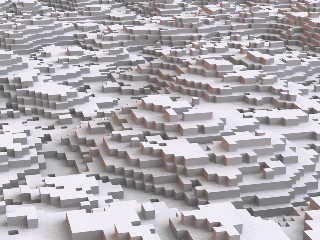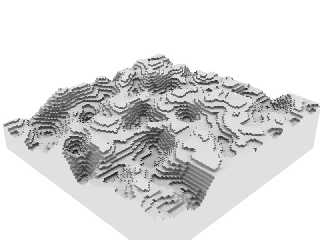 |
 |
|
 |
|
 |
|  |
|  |
|
 |
|
 |
|  |
|  |
|
 |
"Anthony D'Agostino" <gam### [at] contast net> wrote:
> Thanks for posting the macro. Nice render! What kind of light setup did you
> use? GI, HDRI, or area light?
Were you referreing to my original pic? It's radiosity-only lighting. I
rarely use light_sources any more.
L
- net> wrote:
> Thanks for posting the macro. Nice render! What kind of light setup did you
> use? GI, HDRI, or area light?
Were you referreing to my original pic? It's radiosity-only lighting. I
rarely use light_sources any more.
L
-
Post a reply to this message
|
 |
|  |
|  |
|
 |
|
 |
|  |
|  |
|
 |
Just another pic along the same lines, this one heading closer to what I
actually wanted the macro for. This is a granularized version of an
isosurface of a granite pigment, again lit with radiosity only. It looks a
bit 'busy' on the eye, but a bit of focal blur would no doubt clam that
down. Was just a quick render though.
L
-
Post a reply to this message
Attachments:
Download 'granule landscape.jpg' (163 KB)
Preview of image 'granule landscape.jpg'

|
 |
|  |
|  |
|
 |
|
 |
|  |
|  |
|
 |
Post a reply to this message
Attachments:
Download 'granules.jpg' (1 KB)
Download 'granuleshf.jpg' (55 KB)
Preview of image 'granuleshf.jpg'

|
 |
|  |
|  |
|
 |
|
 |
|  |
|  |
|
 |
> Were you referreing to my original pic? It's radiosity-only lighting.
Yes, the csg sphere on the checkered floor. I've been trying to do the same
thing with a python script, blender, and yafray. I haven't used POV in a
while. Is "radiosity-only lighting" some sort of Ambient Occlusion? In other
words, a very large sky-dome surrounds the entire scene and the object is
lit based on how much each point on the surface can see the sky?
Post a reply to this message
|
 |
|  |
|  |
|
 |
|
 |
|  |
|  |
|
 |
> Just another pic along the same lines, this one heading closer to what I
> actually wanted the macro for. This is a granularized version of an
> isosurface of a granite pigment, again lit with radiosity only. It looks
> a
Radiosity only? I can see a very slight reddish hue on the left side of the
cubes. Is this from a gradient-colored sky?
Post a reply to this message
|
 |
|  |
|  |
|
 |
|
 |
|  |
|  |
|
 |
> Radiosity only? I can see a very slight reddish hue on the left side of the
> cubes. Is this from a gradient-colored sky?
Yes, I light things like this quite a lot. It can be time consuming to
render, and takes a lot of tweaking sometimes, but tends to give some nice
results.
A couple of tips. Sometimes images lit like this can look very washed out.
Try increasing the brightness of your sky_sphere way above rgb 1,
particularly in the primary light direction, and then reduce the overall
light level using the brighness keyword in the radiosity block. This will
tend to increase the tonal range of the lighting, but at the expense of
making any reflections look weird - you'll need to tweak things like the
'exponent' of the reflective surfaces to make them look right again.
For example, the sky_sphere I used for the iso-granite-granules image was:
gradient x
color_map {
[0 rgb <5,1,0>]
[0.2 rgb 1]
[0.8 rgb 2]
[1 rgb <7,7,8>]
}
scale 2
translate -x
(rotated as appropriate of course) which required a radiosity brightness of
0.6.
Also you won't get any specular highlights on surfaces as you would do with
direct lighting, but this can be countered by placing a very dim light
(i.e. rgb 0.001 or something) where the primary light would be coming from,
and then using specular values of the order of 1000. This will give you
specular highlights as a result of the light source even though the diffuse
component is negligible. Use light groups to make sure no other lights
affect the surface in ways you don't want.
I'm not saying this stuff is 100% brilliant, but I've used it before to get
some reasonable results. It can be more trouble than its worth.
L
-
Post a reply to this message
|
 |
|  |
|  |
|
 |
|
 |
|  |
|  |
|
 |
DJ Wiza <Kil### [at] sohcahtoa net> wrote:
> Awhile ago, I made a macro similar to this one, but it was based on a
> function. It was more similar to an isosurface that approximated it
> with cubes.
>
> I wonder what kind of result I could get if I used a blob with spheres...
>
I was thinking the same thing, but in reverse.
Two copies of an object, scaled a little, intersection, then macro.
So, should get a surface coating on whatever your normal object is. Maybe tool
around a bit so it coats in a directional manner.
Thinking of trying this as an alternative engine to my surface coating
algorithm, maybe it'll use less memory or something.
Sweet macro though, and I'll certainly be tooling around with uses for it.
Ian net> wrote:
> Awhile ago, I made a macro similar to this one, but it was based on a
> function. It was more similar to an isosurface that approximated it
> with cubes.
>
> I wonder what kind of result I could get if I used a blob with spheres...
>
I was thinking the same thing, but in reverse.
Two copies of an object, scaled a little, intersection, then macro.
So, should get a surface coating on whatever your normal object is. Maybe tool
around a bit so it coats in a directional manner.
Thinking of trying this as an alternative engine to my surface coating
algorithm, maybe it'll use less memory or something.
Sweet macro though, and I'll certainly be tooling around with uses for it.
Ian
Post a reply to this message
|
 |
|  |
|  |
|
 |
|
 |
|  |




![]()